Brief history (DK travel guide): The sprawling grounds of the Summer Palace (Yihe Yuan) served the Qing Dynasty as an imperial retreat from the stifling summer confines of the Forbidden City. Despite existing as an imperial park in earlier dynasties, it was not until the time of Emperor Qianlong, who reigned from 1736-1795, that the Summer Palace assumed its current layout. The palace is most associated, however, with Cixi who had it rebuilt twice: once following its destruction by French and English troops in 1860, and again in 1902 after it was plundered during the Boxer Rebellion.
Empress Dowager Cixi: A higher ranked concubine of Emperor Xianfeng, she was one of history's most powerful women who became the ruler of China in 1881.
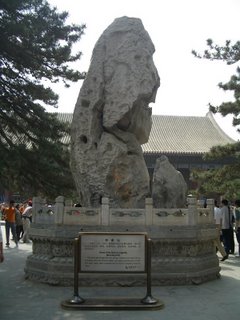


The Longevity stone; Urn; Chinese lion - there is always a pair of them to guard entrances (the male has a ball under his paw while the female has a lion cub under hers)

I swear there is a hall for everything in Chinese palaces (eg: Hall of Increasing Longevity, Hall of Nourishing Pleasures, Hall that Dispels the Clouds - who named these things???). Am not sure how long it would take someone to remember where to go for each ocassion. This is the principal ceremonial hall which houses Cixi's throne.


Entering the Tower of Hill-Lake Scenery (I think)

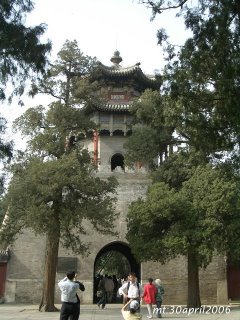
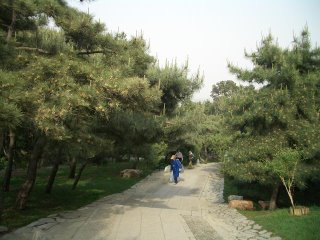


Our lunch spot; another tower; more gardens; trash can; Beijing 2008 Olympics ad - they've even started selling Olympic souvenirs, a bit odd to buy them 2 years before the event though
Imperial Food?


This shop has a sign that reads "Imperial Court Food Specially Prepared for Cixi". Sounds interesting? Wondering what it is? Check out the window to the left of the sign - those are cup noodles. Oh wait, imperial cup noodles, perhaps! (actually they had some rather scary but colourful and ornate looking desserts in there)
Garden of Harmonius Pleasures


I forget the name of the place in the second picture. It's got to be a Hall of some sort. Sorry, after awhile they all look the same. :) All I remember was having to lug myself up another 100 steps or so to get there (after the Great Wall and another 2000 steps or so around other areas here), and that the steps were all made of marble. Way to spend your contrymens' money, emperor!
Jade-like Firmament in Bright Clouds

The complex along the central axes of Longevity Hill starts from the Jade-like Firmament in Bright Clouds, implying the enhancement of each other's beauty between the clouds and the palace. It is inscribed with the historical function and intention of this complex - celebrating Empress Dowagers Cixi's birthday
Jade Belt Bridge

Built with the shadowy blue stone and white marble, this bridge has a thin and high curved arch just as a jade belt. Passing underneath is the estuary of Kunming Lake. This bridge is the only way to YuQuan Mountain for the emperor and empress.
Clear and Peaceful Boat (Marble Boat)


First built in 1755. The 2-story boat was carved out of the shadowy blue stone with a length of 36 metres. It was supposed to be a symbol of stability of the Qing Dynasty, an idea derived from the saying "Water can carry a boat, and it can also capsize a boat", warning the emperor to be diligent in attending to state affairs and love his people, and be prudent in handling the relationship between the rulers and the common people.
Architectural details
Strolling through a Picture Scroll



Long Corridor: The Long Corridor stretches 728 metres long from the Gate of Inviting the Moon in the east to the Shizhang Pavilion in the west, with the Gate of Dispelling Clouds standing in the center and composed of 273 sections. It is the longest and most famous of its kind in the world, with over 14,000 different pictures painted on the beams and crossbeams.
Who designed this thing??? It's brilliant.



Check out the pebbled design of the sidewalks


Painted ceiling in the halls and corridors



Am very disappointed that I cannot trace the designer and/or architect of this place. You'd think that he would be given credit.
The Grand Theatre

And grand it is! Located in the Garden of Virtue and Harmony, it was first built in 1891 and completed in 1895. One of the 3 grand theatres in this Qing Palace. The building is exquisite and elegant, and appraised as the "Cradle of Beijing Opera."
My mind was filled with random shows I'd like to see done here...and none of them were Chinese. How about a Shakespearean play?

This is Cixi's seat, located in the quarters opposite of the Grand Theatre. The sign says "NO PHOTO."
Note: In China, nobody follows rules. That much I have learnt. I would have refrained from taking a picture if the 49 others around me weren't doing so either.


These are some special kind of natural stones. Check out the ones on the right - do you see faces? Actually, they remind me of the sea sponges that I use for scenic painting.
Suzhou Street
Suzhou Street was a famous shopping street in the imperial gardens. It lies in the middle section of the back lake of Longevity Hill, imitating the shops along the canal in Suzhou. It was first built in 1751, destroyed in 1860, and was not restored until 1991.



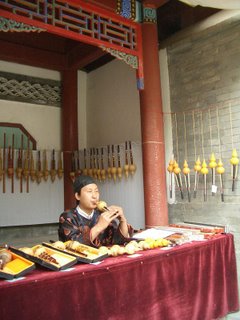

The Summer Palace is arguably one of the most beautiful places in the world and eventhough I have enjoyed exploring it, I couldn't stop myself from cursing the imperial family for such extravagance. Building a replica of an entire Suzhou street complete with shops, etc... just for the emperors is outrageous, espeically when people are dying of hunger in the country. Superstitious Chinese will say that it is due to these sinful extravagance that led to the downfall of the Chinese Imperial families.
Tip: Best to arrive in the morning and spend half the day here. There is too much to see. There is a boat ride you can take to a small island within the palace which I missed because we ran out of time. Perhaps have tea in one of the traditional tea houses on Suzhou Street. Avoid the burgers at the quick snack stalls - the buns are hard and flaky!
Tip: When buying tickets to tourist attractions in China, it's best to buy full package ones. What happens is, you pay say, RMB 40 to enter the place, but within the place itself, there are museums or exhibits which you will need another ticket for. You can choose to purchase just the entrance ticket and buy the extra ones inside, or purchase a full package one right from the start. The full package one will include entrance fees to all exhibits/museums and is a much better deal.
Note: I would also like to add that a lot of the descriptions used are quoted from my handy dandy DK CHINA travel guide. Just in case, you never know who's reading this.

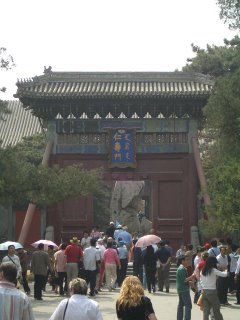
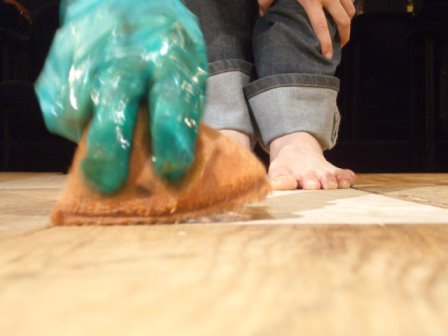
1 comment:
Genial dispatch and this mail helped me alot in my college assignement. Thank you for your information.
Post a Comment